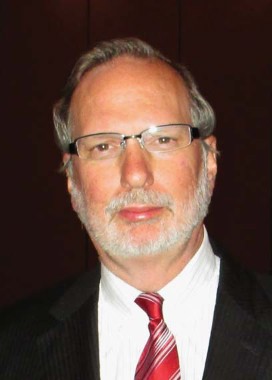User login
NEW YORK – Bicuspid aortic valve repair with reimplantation is feasible with very good midterm outcomes, and the results are getting better as techniques are refined, according to a study presented by Dr. Joseph E. Bavaria at a meeting sponsored by the American Association for Thoracic Surgery.
He and his colleagues performed a retrospective analysis of a prospectively maintained database of patients with bicuspid aortic valve (BAV) disease who had minimal sinus segment dilation or aneurysm, and presented with eccentric, BAV aortic insufficiency (AI) alone, with only a dilated annulus. In these patients, the study showed that simple repair with subcommissural annuloplasty (SCA) was not an appropriate treatment choice, since it was associated with heightened risk of AI recurrence, compared with cusp repair combined with root implantation. The worst outcomes were seen for those who underwent SCA when the preoperative annular diameter was 28 mm or more.
"A fundamental dilemma for surgeons today worldwide is the decision to either repair an insufficient BAV or perform an aortic valve replacement (or a Bentall)," said Dr. Bavaria, director of the thoracic aortic surgery program at the University of Pennsylvania Medical Center, Philadelphia. "The key overall conceptual question in front of the cardioaortic surgical community is: Can we repair virtually every pure BAV AI presentation as we presently perform in the mitral valve repair arena?"
This study analyzed data from 88 patients with type I BAV disease who had AI (with or without aortic root aneurysm), who underwent primary valve repair between 2002 and 2013. The reimplantation group (n = 36) underwent primary leaflet repair and annular stabilization by root reimplantation, and the repair group (n = 52) underwent primary leaflet repair with subannular stabilization by SCA.
At 5 years, freedom from AI recurrence was significantly better in the reimplantation group than in the repair group (92% vs. 62%; P = .03). Overall survival was 100% for both groups. Results from a smaller cohort were published recently (Ann. Thorac. Surg. 2014;97:1227-34).
"In patients who have minimal sinus segment dilation or aneurysm and present with eccentric, BAV AI alone, with only a dilated annulus, it is becoming increasingly obvious and understood that this reparative technique [simple repair with SCA] is inadequate," said Dr. Bavaria.
Subgroup analysis showed that SCA in patients with enlarged annular diameters had poor outcomes. In those who underwent SCA, 88% of those with small preoperative annular diameters (27 mm or less) had no AI recurrence, compared with only 53% of those with larger diameters (28 mm or more) (P = .02). Root implantation was associated with excellent outcomes, regardless of preoperative annular size (100% vs. 88%; P = .30). "We have abandoned this particular procedure [SCA for these patients]," said Dr. Bavaria, noting that in his practice, he reserves SCA only for those who have normal annular size (27 mm or less) and a nonaneurysmal root.
Dr. Bavaria outlined some risk factors he associates with poor outcomes in BAV repair. These include excessive calcification of the leaflets, including the commissures or raphe; severely enlarged annular diameters without robust subannular stabilization; leaflet surface areas that are not adequate to provide excellent cusp coaptation (and therefore would require leaflet augmentation); and reimplantation with very extensive cusp repair.
Dr. Bavaria reported no relevant financial disclosures.
NEW YORK – Bicuspid aortic valve repair with reimplantation is feasible with very good midterm outcomes, and the results are getting better as techniques are refined, according to a study presented by Dr. Joseph E. Bavaria at a meeting sponsored by the American Association for Thoracic Surgery.
He and his colleagues performed a retrospective analysis of a prospectively maintained database of patients with bicuspid aortic valve (BAV) disease who had minimal sinus segment dilation or aneurysm, and presented with eccentric, BAV aortic insufficiency (AI) alone, with only a dilated annulus. In these patients, the study showed that simple repair with subcommissural annuloplasty (SCA) was not an appropriate treatment choice, since it was associated with heightened risk of AI recurrence, compared with cusp repair combined with root implantation. The worst outcomes were seen for those who underwent SCA when the preoperative annular diameter was 28 mm or more.
"A fundamental dilemma for surgeons today worldwide is the decision to either repair an insufficient BAV or perform an aortic valve replacement (or a Bentall)," said Dr. Bavaria, director of the thoracic aortic surgery program at the University of Pennsylvania Medical Center, Philadelphia. "The key overall conceptual question in front of the cardioaortic surgical community is: Can we repair virtually every pure BAV AI presentation as we presently perform in the mitral valve repair arena?"
This study analyzed data from 88 patients with type I BAV disease who had AI (with or without aortic root aneurysm), who underwent primary valve repair between 2002 and 2013. The reimplantation group (n = 36) underwent primary leaflet repair and annular stabilization by root reimplantation, and the repair group (n = 52) underwent primary leaflet repair with subannular stabilization by SCA.
At 5 years, freedom from AI recurrence was significantly better in the reimplantation group than in the repair group (92% vs. 62%; P = .03). Overall survival was 100% for both groups. Results from a smaller cohort were published recently (Ann. Thorac. Surg. 2014;97:1227-34).
"In patients who have minimal sinus segment dilation or aneurysm and present with eccentric, BAV AI alone, with only a dilated annulus, it is becoming increasingly obvious and understood that this reparative technique [simple repair with SCA] is inadequate," said Dr. Bavaria.
Subgroup analysis showed that SCA in patients with enlarged annular diameters had poor outcomes. In those who underwent SCA, 88% of those with small preoperative annular diameters (27 mm or less) had no AI recurrence, compared with only 53% of those with larger diameters (28 mm or more) (P = .02). Root implantation was associated with excellent outcomes, regardless of preoperative annular size (100% vs. 88%; P = .30). "We have abandoned this particular procedure [SCA for these patients]," said Dr. Bavaria, noting that in his practice, he reserves SCA only for those who have normal annular size (27 mm or less) and a nonaneurysmal root.
Dr. Bavaria outlined some risk factors he associates with poor outcomes in BAV repair. These include excessive calcification of the leaflets, including the commissures or raphe; severely enlarged annular diameters without robust subannular stabilization; leaflet surface areas that are not adequate to provide excellent cusp coaptation (and therefore would require leaflet augmentation); and reimplantation with very extensive cusp repair.
Dr. Bavaria reported no relevant financial disclosures.
NEW YORK – Bicuspid aortic valve repair with reimplantation is feasible with very good midterm outcomes, and the results are getting better as techniques are refined, according to a study presented by Dr. Joseph E. Bavaria at a meeting sponsored by the American Association for Thoracic Surgery.
He and his colleagues performed a retrospective analysis of a prospectively maintained database of patients with bicuspid aortic valve (BAV) disease who had minimal sinus segment dilation or aneurysm, and presented with eccentric, BAV aortic insufficiency (AI) alone, with only a dilated annulus. In these patients, the study showed that simple repair with subcommissural annuloplasty (SCA) was not an appropriate treatment choice, since it was associated with heightened risk of AI recurrence, compared with cusp repair combined with root implantation. The worst outcomes were seen for those who underwent SCA when the preoperative annular diameter was 28 mm or more.
"A fundamental dilemma for surgeons today worldwide is the decision to either repair an insufficient BAV or perform an aortic valve replacement (or a Bentall)," said Dr. Bavaria, director of the thoracic aortic surgery program at the University of Pennsylvania Medical Center, Philadelphia. "The key overall conceptual question in front of the cardioaortic surgical community is: Can we repair virtually every pure BAV AI presentation as we presently perform in the mitral valve repair arena?"
This study analyzed data from 88 patients with type I BAV disease who had AI (with or without aortic root aneurysm), who underwent primary valve repair between 2002 and 2013. The reimplantation group (n = 36) underwent primary leaflet repair and annular stabilization by root reimplantation, and the repair group (n = 52) underwent primary leaflet repair with subannular stabilization by SCA.
At 5 years, freedom from AI recurrence was significantly better in the reimplantation group than in the repair group (92% vs. 62%; P = .03). Overall survival was 100% for both groups. Results from a smaller cohort were published recently (Ann. Thorac. Surg. 2014;97:1227-34).
"In patients who have minimal sinus segment dilation or aneurysm and present with eccentric, BAV AI alone, with only a dilated annulus, it is becoming increasingly obvious and understood that this reparative technique [simple repair with SCA] is inadequate," said Dr. Bavaria.
Subgroup analysis showed that SCA in patients with enlarged annular diameters had poor outcomes. In those who underwent SCA, 88% of those with small preoperative annular diameters (27 mm or less) had no AI recurrence, compared with only 53% of those with larger diameters (28 mm or more) (P = .02). Root implantation was associated with excellent outcomes, regardless of preoperative annular size (100% vs. 88%; P = .30). "We have abandoned this particular procedure [SCA for these patients]," said Dr. Bavaria, noting that in his practice, he reserves SCA only for those who have normal annular size (27 mm or less) and a nonaneurysmal root.
Dr. Bavaria outlined some risk factors he associates with poor outcomes in BAV repair. These include excessive calcification of the leaflets, including the commissures or raphe; severely enlarged annular diameters without robust subannular stabilization; leaflet surface areas that are not adequate to provide excellent cusp coaptation (and therefore would require leaflet augmentation); and reimplantation with very extensive cusp repair.
Dr. Bavaria reported no relevant financial disclosures.
AT AATS AORTIC SYMPOSIUM 2014
Key clinical point: The researchers reserve subcommissural annuloplasty only for those patients with a normal annular size (27 mm or less) and a nonaneurysmal root.
Major finding: Bicuspid aortic valve patients having subcommissural annuloplasty had significantly better freedom from AI recurrence at 5 years than did those treated using the reimplantation technique (92% vs. 62%).
Data source: Retrospective study of 88 patients with type I BAV disease.
Disclosures: Dr. Bavaria reported no relevant financial disclosures.

